II. Group Erotics
Aernout Mik discusses the erotics of sameness and collective emotions.
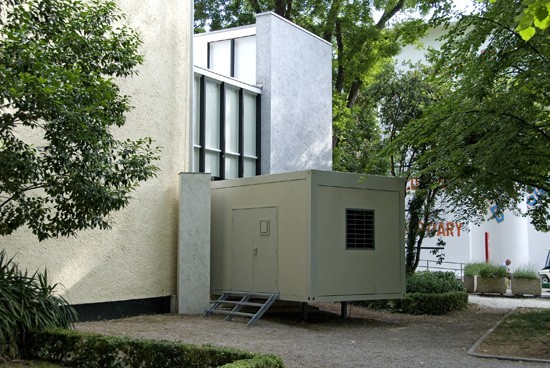
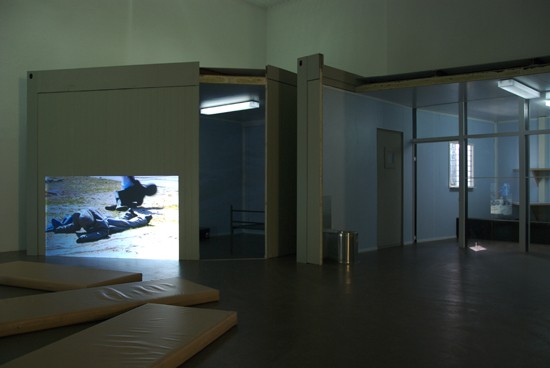 Top: Exterior view of “Citizens and Subjects,” Dutch Pavilion at the 52nd Venice Biennale, 2007; photo Victor Nieuwenhuis. Bottom: Installation view of Training Ground (2007) in “Citizens and Subjects,” Dutch Pavilion at the 52nd Venice Biennale, 2007; photo Victor Nieuwenhuis. All images: Courtesy Aernout Mik and carlier❘gebauer, Berlin.
Top: Exterior view of “Citizens and Subjects,” Dutch Pavilion at the 52nd Venice Biennale, 2007; photo Victor Nieuwenhuis. Bottom: Installation view of Training Ground (2007) in “Citizens and Subjects,” Dutch Pavilion at the 52nd Venice Biennale, 2007; photo Victor Nieuwenhuis. All images: Courtesy Aernout Mik and carlier❘gebauer, Berlin.ART iT: We were just discussing the balance between documentation and fiction, formalism and realism in your works. In this regard I have to say I found your installation “Citizens and Subjects” for the Dutch Pavilion at the 52nd Venice Biennale to be somewhat problematic. I thought it was over-reaching in its recreation of the atmosphere of a detention center as an environment for viewing the videos that were on display, Training Ground (2006), Convergencies (2007) and Mock Up (2007). In contrast to your other installations incorporating simple walls or partitions, the connotative sculptural or architectural elements in Venice seemed to determine how the videos should be interpreted. Have you reflected much on “Citizens and Subjects” since it was completed?
AM: To me, the essential part of the installation was a kind of gap where the two parts in the show didn’t fully connect. This unresolved split was the dynamic force in the installation for me. I connected the motive of the disaster exercise – coming from the fear of catastrophe – with the way we train and perform border controls to deal with illegal immigration, and these two elements were folded into each other in the pavilion. A kind of transition zone was created between the two. Although they speak about different things, however unresolved for me, they also belong together, and had to be thought of together.
I was also investigating the relationship between action and rehearsal, training and acting out, and even the acting out of acting out: the staging of a training. Of course you could say the sculptural and architectural elements of the pavilion were clearly drawn from the look of a detention center, but even as it evoked a restrictive space it was also an exploded space, in that the container elements were both penetrating the pavilion and extending from the inside to the outside. I was trying to create these paradoxes or reversals, and in doing so trying to alter the nature and direction of the whole situation.
ART iT: You mentioned that your work is now more socially engaged than it was previously. Early videos like Kitchen (1997) or Garage (1998) still have an aspect of formalism, experimenting with behavior in space. What was the work that changed your focus?
AM: In the early videos I was playing with simple, basic rules that the actors had to follow. People might call it absurdist, but I was never interested in absurdism. If you think about it too long, any rule becomes absurd, so the word just doesn’t say anything to me. I would say it was more behaviorist, in that the actors were operating only within specific and limited conditions.
Then in the late 1990s I became interested in the phenomenon of the disaster movie. I think this was the start of the transition, with pieces like Softer Catwalk in Collapsing Room (1999) and Organic Escalator (2000), where I operated more with direct lines to after-images from the mass media of group situations in public space. For instance, Organic Escalator is set in a warehouse or department store. And then the motives behind collective fear, anger and paralysis pushed my interests another step further, so in pieces like Glutinosity (2001) or Middlemen (2001) these collective social emotions are even more explicit.
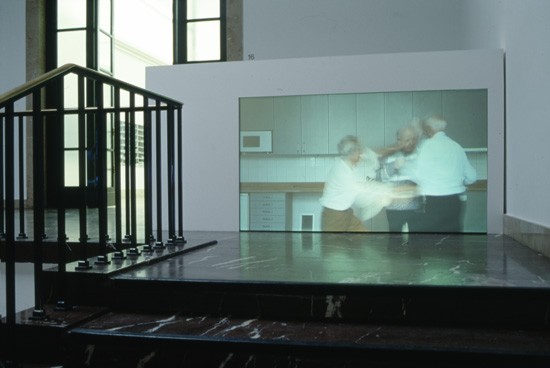
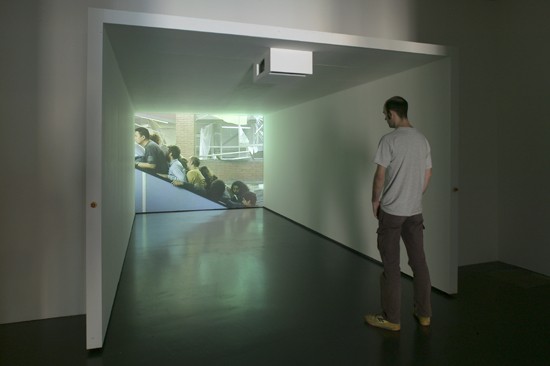 Top: Installation view of Kitchen (1997) at Haus der Kunst, Munich, 2002. Bottom: Installation view of Organic Escalator (2000) at Caixa Forum, Barcelona, 2003.
Top: Installation view of Kitchen (1997) at Haus der Kunst, Munich, 2002. Bottom: Installation view of Organic Escalator (2000) at Caixa Forum, Barcelona, 2003.ART iT: Many of your works seem to have a subtly erotic or even homoerotic element. Would you say you are also investigating a kind of social erotics?
AM: Certainly in Kitchen there are some almost homoerotic moments. A bit in a Gombrowicz sense (as in the novel Ferdydurke, 1937), I asked the performers to recall their own experiences of playing and fighting in the schoolyard, so there was a physical tension inside them of attempting to evoke bodily memories of youth through their old bodies. I am interested in the erotics of the group, an erotics of sameness in which members of the group are all equally part of that group and physically engaged with each other or determined by each other. There is something that connects and spreads through the group and sometimes spreads even from people into objects, creating a kind of animism.
ART iT: In such works, do you have something that you want to address in mind, or are you observing a social situation and then reenacting it?
AM: I’m never just reenacting a situation. There’s a reenacting moment because these are situations with which we are familiar or have ideas about or fear, but as I develop these pieces I try to dig out counter movements that oppose the direct imagery or reveal something else that goes in another direction. The ultimate effect is that there’s something unfulfilled. I like this idea that you look at an image, you encounter something and you immediately classify it and give it a certain identity, but as you spend more time with it, it starts to fall apart. Organic Escalator is about a disaster situation, but there’s also a softness to it. This is something that I often try to bring to the surface when I’m preparing and realizing these pieces. I’m interested in a dialectical image that carries within it its own counterparts, and therefore remains active and does not say only one thing: an image that represents many different things at the same time without coming to completion, so that it enables you to engage actively with the subject matter of the work. This is what I hope is taking place.
This is the same method I was describing in the pavilion of having two worlds that don’t completely relate to each other, but at the same time it is impossible to deny that they do have a relation. There’s a contamination from one to the other and they say something about each other, but you cannot use one to explain the other. You have to think them at the same time because they are in a state of constant flux, and I think this is completely different from the idea of reenacting.
ART iT: In that sense you touch upon politically-charged issues without making definitive statements about them. What do you hope viewers can take away from your work?
AM: I would say the work should create a field where you are stimulated to develop impulses of a political awareness and activity. The function of the exhibition is to establish a social arena where these vectors can emerge among other people. That’s the beauty of the exhibition space, that it is a collective space. Of course we can also have a sense of community through something like the Internet, and maybe it’s nostalgia on my part, but I feel there are less occasions now for actually being in space together.
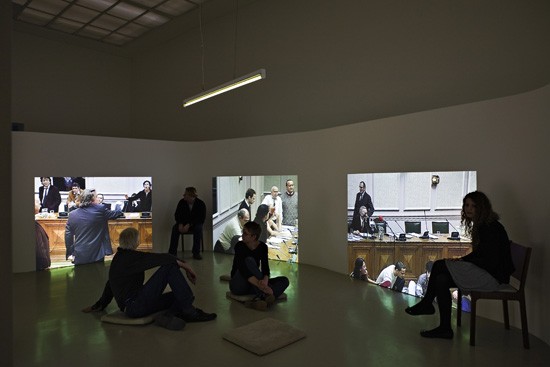
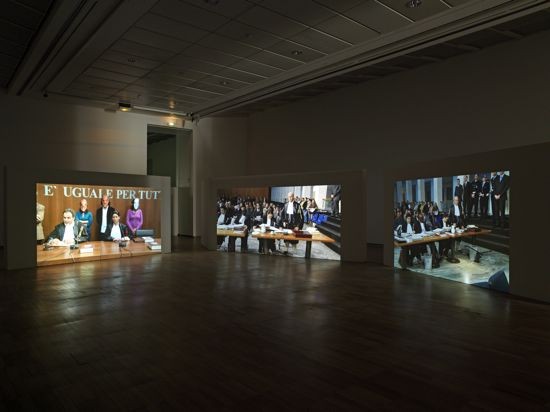 Top: Installation view of Vacuum Room (2005) at Kunstverein Hannover, 2007. Bottom: Installation view of Shifting Sitting II (2011) at Jeu de Paume, Paris, 2011; photo Arno Gisinger.
Top: Installation view of Vacuum Room (2005) at Kunstverein Hannover, 2007. Bottom: Installation view of Shifting Sitting II (2011) at Jeu de Paume, Paris, 2011; photo Arno Gisinger.ART iT: Well, Western Europe is strongly associated with the idea of democracy, perhaps even more so than the US, but what always strikes me in the airports there is seeing the armed security patrols and having this strong sense of having entered a police state. People seem to have accepted the idea that democracy needs control.
AM: Democracy itself is in a deep crisis in Europe, not just because of the control that is taking place, but also because the whole idea of representation is in an enormous crisis. No one has an answer to it at this point.
ART iT: For me, one of your most powerful works is Vacuum Room (2005), with the protesters who have entered some kind of legislative chamber and are disrupting the proceedings there. It may not have a specific objective, but what affects me about the work is that it communicates the possibility that there are still many ways for citizens to intervene in government.
AM: Exactly. There are all these streams of action that suddenly crystallize into a certain moment, like the possibility of resistance by the people. These appear almost like after-images that viewers carry with them and which can develop into their own cells of possibility. They offer something, and that’s how I want to work. That’s why it’s political, even if few people in the political world would have any idea how to relate to my work.
Aernout Mik: Possession/Form
